Fourth in a series by Antique Jewelry Collector Paul Royse. See the first one here.
Antique Pearl Jewelry that YOU could own - The Victorian Period
By Paul Royse
The Victorian Era is named after the British Queen Victoria, and covers the period of her reign from 1831 to 1901.
During this time the industrial revolution rapidly progressed. Gaslights, piped water, and sewage systems were installed in city homes. Stream trains replaced horse drawn passenger carriages, the telegraph replaced the mail coach, and steam ships replaced sailing ships.
Improved transport opened up new territories, and gold was discovered in distant lands, leading to gold rushes in Australia, New Zealand, Brazil, Canada, South Africa, and California. Fortunes were made, and more gold reached the jewelry trade.
The Victorian Era was relatively prosperous. Ownership of jewelry became more widespread as incomes increased and pieces became more affordable due to mass production and imports from abroad. Pearls rose to become a standard feature of fine jewelry.
One of the most prominent styles of Victorian times is the Classical Revival. In 1836 spectacular gold jewelry was found in Etruscan tombs dating to circa 640BC. This inspired the Roman jeweler Fortunato Pio Castellani to rediscover the ancient goldsmiths' techniques, and started a craze for Etruscan Revival jewelry that soon extended to a Classical Revival based on Greek and Roman designs.
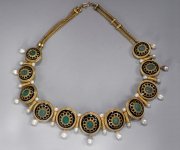
Image courtesy of Cooper Hewitt, Smithsonian Design Museum.
Pearls' prominent place in Victorian jewelry was a carry-over from their past importance as royal jewels and also reflected their availability versus other gems. Sea pearls were still plentiful, with the major source of supply now coming from the Persian Gulf.
Fresh water pearls were also harvested in quantity, especially from the Mississippi River in USA and the River Tay in Scotland. Their varied and often elongated shapes were used in a variety of creative designs such as the following C19th examples containing pearls from American fresh water mussels.
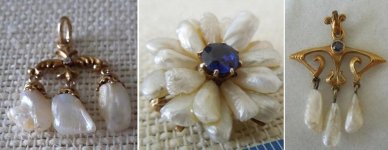
Images courtesy of Pearl-Guide member Andrea Shipley (NextGenJewelry.etsy.com)
While pearls were plentiful, diamonds were scarce. Until the 1700's diamonds came from diminishing stocks in India, and then from alluvial deposits in Brazil. However these sources meant only limited quantities of diamonds were available until the late 1800's, when the South African underground diamond mines began production.
The following necklace is a classic Early Victorian girandole diamond pendant, suspended from a seed pearl necklace. The name girandole originally referred to a triple candelabra with crystal drops. Diamond pendants and earrings with three dangling drops became a standard form in late Georgian and Early Victorian times, when the mobile drops were particularly attractive and effective at catching sparkles under candle light.
Note that the diamonds in this girandole pendant are set in silver mounts on a backing of gold. Silver was the standard white metal used to enhance the appearance of diamonds throughout the 1700's and 1800's, until platinum came into widespread use in jewelry around 1900.
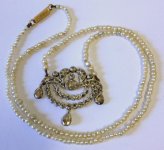
Image courtesy of Pearl-Guide member Helen Byrne (Fidra Jewellers, Brighton www.fidra.com)
The sparkle and glitter of social occasions in the increasingly affluent Victorian era were set back in 1861 by the death of Queen Victoria's husband, Prince Albert.
Victoria went into a prolonged period of mourning, and she wore black "widows weeds" for the rest of her life. This influenced the fashions of the time, and a more austere look that included black clothing and jewelry came into vogue, even among people not in actual mourning.
Black materials like agate, jet and onyx were often used in jewelry of this period, and contrasting white on black hardstone cameos were popular. The wealthy would have a custom cameo carved to depict a loved one, or for a little less one could buy an off-the-shelf cameo portrait of an admired celebrity or historical character.
Pearl borders provided an attractive decorative detail for black and white jewelry, seen here in this fine Mid-Victorian hardstone cameo pendant. The subject is Mary Queen of Scots, identified by her necklace of pearls.
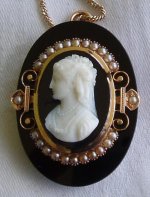
Image courtesy of a Pearl-Guide member
Mary was famous for her pearls. Her Scottish freshwater pearl necklace was previously discussed on the Pearl-Guide forum here. Mary also owned one the greatest of all pearl necklaces, the "Hanoverian Pearls". These were six long stands of large matched black pearls. They were a wedding present to Mary from her husband Dauphin Francis via his parents Catherine di Medici and King Henry II of France. The necklace was looted from Mary while she was imprisoned, then sold to Elizabeth I (the Hanoverian Pearls are worn by Elizabeth in the portrait shown in the introduction to this series here).
The Victorian Era was full of variety and contrasting influences. Alongside the classical revival and austerity of formal and mourning jewelry, exotic items reached the West from the Middle East, Indian subcontinent, China and Japan. These pieces from far away places, like the antique Indian nose ring below, with its mix of colored gems and pearls, were unlike anything seen before, and soon began to influence decorative schemes and fashions. A craze for the exotic arose, which is now known as the Aesthetic Movement, or the "Cult of Beauty".
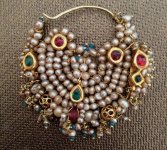
Photograph by Jainamishra, Courtesy of Jainamishra and Wikimedia Commons
In the Late Victorian period, from about 1871, a sustained period of prosperity and optimism commenced in Europe and USA. In French and Belgian history this is called the Belle ?poque (Beautiful Era), in the USA it was the Gilded Age. It was a time when diamonds were dazzling, pearls were precious, and jewelry was a favorite way for the newly rich to flaunt their wealth. The following spectacular brooch and rings are prime examples from the period.
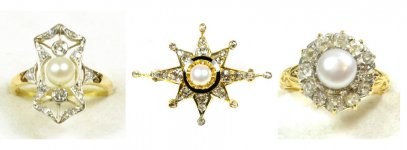
Images courtesy of Pearl-Guide member Helen Byrne (Fidra Jewellers, Brighton www.fidra.com)
Alongside the Belle ?poque two important and complimentary fashions emerged. First came the Arts & Crafts movement, with hand-crafted jewelry that emphasized the artistic merit of items rather than their intrinsic value. Soon after came Art Nouveau, which took its inspiration from the beauty of nature. These two styles will be reviewed soon. However before that, in the next article, we'll look at the Victorian period's brief successor (which also coincided with the end of the Belle ?poque), the Edwardian Era, which ran from 1900-1914.
Collectors Tips
Victorian jewelry is relatively plentiful and varies hugely in quality and value. However the differences between common and rare items are not always obvious.
As the Victorian period progressed mechanization reached the jewelry trade. Steam driven presses and rolling mills meant jewelry components could be mass produced. Most Late Victorian Etruscan Revival jewelry was made using production line techniques and so has limited value beyond its precious metal content.
In contrast the Etruscan and Classical Revival pieces by the Castellani and Giuliano families were all hand made to the highest standards, and these are now extraordinarily valuable.
Your average High Street (or shopping mall) jeweler is most unlikely to know the difference between mass produced and museum piece. Tragically, the gold buyer in that kiosk in the mall will be looking at the weight on their scales, not the quality of the fabrication.
If you have inherited or been gifted an item of Victorian jewelry, and don't know its provenance, it is worth carefully investigating its origins. If the piece contains pearls, then join the Pearl-Guide forum, where you'll find a friendly group of pearl lovers willing to help you identify your treasures.
To read the next installment on the Edwardian Period, click here.
Antique Pearl Jewelry that YOU could own - The Victorian Period
By Paul Royse
The Victorian Era is named after the British Queen Victoria, and covers the period of her reign from 1831 to 1901.
During this time the industrial revolution rapidly progressed. Gaslights, piped water, and sewage systems were installed in city homes. Stream trains replaced horse drawn passenger carriages, the telegraph replaced the mail coach, and steam ships replaced sailing ships.
Improved transport opened up new territories, and gold was discovered in distant lands, leading to gold rushes in Australia, New Zealand, Brazil, Canada, South Africa, and California. Fortunes were made, and more gold reached the jewelry trade.
The Victorian Era was relatively prosperous. Ownership of jewelry became more widespread as incomes increased and pieces became more affordable due to mass production and imports from abroad. Pearls rose to become a standard feature of fine jewelry.
One of the most prominent styles of Victorian times is the Classical Revival. In 1836 spectacular gold jewelry was found in Etruscan tombs dating to circa 640BC. This inspired the Roman jeweler Fortunato Pio Castellani to rediscover the ancient goldsmiths' techniques, and started a craze for Etruscan Revival jewelry that soon extended to a Classical Revival based on Greek and Roman designs.

Image courtesy of Cooper Hewitt, Smithsonian Design Museum.
Pearls' prominent place in Victorian jewelry was a carry-over from their past importance as royal jewels and also reflected their availability versus other gems. Sea pearls were still plentiful, with the major source of supply now coming from the Persian Gulf.
Fresh water pearls were also harvested in quantity, especially from the Mississippi River in USA and the River Tay in Scotland. Their varied and often elongated shapes were used in a variety of creative designs such as the following C19th examples containing pearls from American fresh water mussels.

Images courtesy of Pearl-Guide member Andrea Shipley (NextGenJewelry.etsy.com)
While pearls were plentiful, diamonds were scarce. Until the 1700's diamonds came from diminishing stocks in India, and then from alluvial deposits in Brazil. However these sources meant only limited quantities of diamonds were available until the late 1800's, when the South African underground diamond mines began production.
The following necklace is a classic Early Victorian girandole diamond pendant, suspended from a seed pearl necklace. The name girandole originally referred to a triple candelabra with crystal drops. Diamond pendants and earrings with three dangling drops became a standard form in late Georgian and Early Victorian times, when the mobile drops were particularly attractive and effective at catching sparkles under candle light.
Note that the diamonds in this girandole pendant are set in silver mounts on a backing of gold. Silver was the standard white metal used to enhance the appearance of diamonds throughout the 1700's and 1800's, until platinum came into widespread use in jewelry around 1900.

Image courtesy of Pearl-Guide member Helen Byrne (Fidra Jewellers, Brighton www.fidra.com)
The sparkle and glitter of social occasions in the increasingly affluent Victorian era were set back in 1861 by the death of Queen Victoria's husband, Prince Albert.
Victoria went into a prolonged period of mourning, and she wore black "widows weeds" for the rest of her life. This influenced the fashions of the time, and a more austere look that included black clothing and jewelry came into vogue, even among people not in actual mourning.
Black materials like agate, jet and onyx were often used in jewelry of this period, and contrasting white on black hardstone cameos were popular. The wealthy would have a custom cameo carved to depict a loved one, or for a little less one could buy an off-the-shelf cameo portrait of an admired celebrity or historical character.
Pearl borders provided an attractive decorative detail for black and white jewelry, seen here in this fine Mid-Victorian hardstone cameo pendant. The subject is Mary Queen of Scots, identified by her necklace of pearls.

Image courtesy of a Pearl-Guide member
Mary was famous for her pearls. Her Scottish freshwater pearl necklace was previously discussed on the Pearl-Guide forum here. Mary also owned one the greatest of all pearl necklaces, the "Hanoverian Pearls". These were six long stands of large matched black pearls. They were a wedding present to Mary from her husband Dauphin Francis via his parents Catherine di Medici and King Henry II of France. The necklace was looted from Mary while she was imprisoned, then sold to Elizabeth I (the Hanoverian Pearls are worn by Elizabeth in the portrait shown in the introduction to this series here).
The Victorian Era was full of variety and contrasting influences. Alongside the classical revival and austerity of formal and mourning jewelry, exotic items reached the West from the Middle East, Indian subcontinent, China and Japan. These pieces from far away places, like the antique Indian nose ring below, with its mix of colored gems and pearls, were unlike anything seen before, and soon began to influence decorative schemes and fashions. A craze for the exotic arose, which is now known as the Aesthetic Movement, or the "Cult of Beauty".

Photograph by Jainamishra, Courtesy of Jainamishra and Wikimedia Commons
In the Late Victorian period, from about 1871, a sustained period of prosperity and optimism commenced in Europe and USA. In French and Belgian history this is called the Belle ?poque (Beautiful Era), in the USA it was the Gilded Age. It was a time when diamonds were dazzling, pearls were precious, and jewelry was a favorite way for the newly rich to flaunt their wealth. The following spectacular brooch and rings are prime examples from the period.

Images courtesy of Pearl-Guide member Helen Byrne (Fidra Jewellers, Brighton www.fidra.com)
Alongside the Belle ?poque two important and complimentary fashions emerged. First came the Arts & Crafts movement, with hand-crafted jewelry that emphasized the artistic merit of items rather than their intrinsic value. Soon after came Art Nouveau, which took its inspiration from the beauty of nature. These two styles will be reviewed soon. However before that, in the next article, we'll look at the Victorian period's brief successor (which also coincided with the end of the Belle ?poque), the Edwardian Era, which ran from 1900-1914.
Collectors Tips
Victorian jewelry is relatively plentiful and varies hugely in quality and value. However the differences between common and rare items are not always obvious.
As the Victorian period progressed mechanization reached the jewelry trade. Steam driven presses and rolling mills meant jewelry components could be mass produced. Most Late Victorian Etruscan Revival jewelry was made using production line techniques and so has limited value beyond its precious metal content.
In contrast the Etruscan and Classical Revival pieces by the Castellani and Giuliano families were all hand made to the highest standards, and these are now extraordinarily valuable.
Your average High Street (or shopping mall) jeweler is most unlikely to know the difference between mass produced and museum piece. Tragically, the gold buyer in that kiosk in the mall will be looking at the weight on their scales, not the quality of the fabrication.
If you have inherited or been gifted an item of Victorian jewelry, and don't know its provenance, it is worth carefully investigating its origins. If the piece contains pearls, then join the Pearl-Guide forum, where you'll find a friendly group of pearl lovers willing to help you identify your treasures.
To read the next installment on the Edwardian Period, click here.

